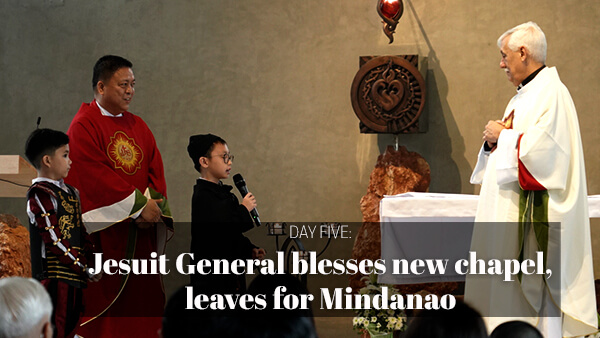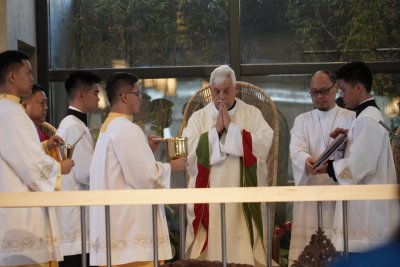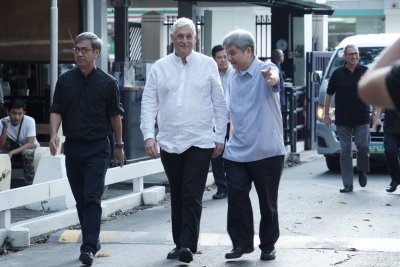


December 13, 2018
Fr. General Arturo Sosa spent a quiet evening on 11 December at the Jesuit Community’s residence at Sacred Heart School. He would have a long day ahead on 12 December, Wednesday, Feast of Our Lady of Guadalupe, Patroness of the Americas and the Philippines.
At 8:30 AM of Wednesday Fr. Sosa was brought by van to the front of the new Cor Jesu, the chapel of SHS-AdC, which he was scheduled to bless at 9:00 AM.
SHS-AdC outdid itself in its warm welcome of Fr. Sosa. There in front of the chapel were students from the school who greeted him and his party warmly. Most enthusiastic were grade school students, who waved the flags of the Philippines and Venezuela and shouted greetings in Spanish. He then proceeded to the vesting area where Jesuits assigned to Cebu, Iloilo and Manila were instructed to proceed.
At 9:00 AM, the rite of blessing began under the direction of Fr. Edwin Castillo as Master of Ceremonies. Fr. Castillo explained that the chapel was not yet blessed hence there would be some variation in the Eucharistic liturgy; the priests would not kiss the altar until after the rite of blessing of the altar, which would follow the Gospel and homily.
Cor Iesu as explained by Fr. Manuel Uy, director of SHS-AdC was a project long in completing, going back as far a decade ago and having passed the gauntlet of a number of studies and proposals until a design was agreed upon. Fr. Hernando, former director of SHS-AdC, who was one of those who pushed for the project, flew from Manila to be at the blessing, grateful and visibly moved at seeing the chapel a reality.
The Cor Jesu is unique among modern Philippine churches for its undulating roof suggesting an eagle and its young, waves and currents of the sea or “sulug” in Visayan or, as a Jesuit observed, the flow of love between the heart of Jesus and his people. The exterior walls of this reinforced concrete and steel structure is softened by vertical poles of bamboo. The bamboo also forms the interior ceiling, which follows the lines of the roof. In the Orient, the bamboo is a symbol of resiliency as it is able to sway with high winds and not break. It’s potential as an sustainable and renewable resource is being discovered and used in various projects from small things such as biodegradable and reusable drinking straws and large as dwellings.
Cor Jesu is by Sacred Heart School alumnus and internationally acclaimed designer Kenneth Cobonpue whose furniture using tropical material like bamboo, rattan and vine has won awards in international competitions and a strong international following by celebrities. Cor Jesu is his first church project.
Besides Cobonpue were other designers like architect Vincent Pinpin, who had worked in previous Jesuit university projects; metal sculptor Juan Sajid Imao, son of Philippine National Artist Abdulmari Imao; sculptor Justino “Paloy” Cagayat and stone-artist Bryan Manubag.
In his homily, Fr. Sosa took note of the feast during which the Cor Jesu was being blessed, the Feast of Our Lady of Guadalupe. He noted that in the Basilica of Nuestra Señora de Guadalupe are the flags of 27 nations that has Guadalupe as patron; 26 are from the Americas and only one from Asia, the Philippines. He said that like the Philippines, Venezuela also has Guadalupe as patron. He also noted the personal significance of the feast for him. On this day, his parents were married. He was baptized on 12 December and pronounced his final vows also on this day. 
Fr. Sosa recounted briefly the story of Juan Diego, the lowly Indian to whom Mary appeared at Tepeyac Hill, the site of an Aztec temple. He drew parallels between the Virgin Mary who visited her cousin Elizabeth and Juan Diego. Just as the powerless, unknown Mary brought Jesus to Elizabeth, so did the peasant Juan Diego become a messenger of God’s invitation to the peoples of the Americas. Then, citing his experience at the recently concluded Synod of Youth in Rome, Fr. Sosa remarked that young people are looking for a welcoming Church, close to the poor. Youth spoke with candor before the bishops, they, the small ones, were ambassadors of the Lord.
Thanking the generosity of all who worked to build the Cor Jesu, he suggested that when the Guadalupe asked Juan Diego to have a church built at Tepeyac, she meant not so much a structure of stone and mortar, but a living Church of believers, a community of joyful members, friends working with the Lord. He cited the example of Fr. Velandria from Venezuela, whose bishop was urging him to build a church for a long time. But Father never got to erecting a physical structure because for a decade he was building the Church community. After a decade, the people themselves built a Church together.
Finally, he spoke of the love of the Virgin Mary, who assured Juan Diego, as he hesitated to tell the bishop of his marvelous encounter on the hill, not to fear. She also assures the community of SHS-AdC of such loving presence, expressed in the Guadalupe’s message: “Am I not here your mother?”
Incense, candles, flowers, orchestral and choral music filled this joyful celebration. Words of thanks and acknowledgment were expressed by Fr. Manuel Uy, the president SHS-AdC. But the final grace note of the blessing were four brief messages and prayers addressed to Fr. Sosa by grade school boys, one dressed as Iñigo the soldier, Ignatius the founder, Pope Francis and Fr. Sosa’s alter ego.
Iñigo prayed that the Jesuits would not give him headaches but be obedient like true soldiers. Ignatius stressed the importance of prayer. Pope Francis reminded Fr. General to send Jesuits to the peripheries without counting the cost. Fr. Sosa’s alter ego, who had streaked his hair white, said to Arturo that he was not getting any younger, so he had to eat well, to take care of his health, to not forget his siesta and to exercise. Fr. Sosa was delighted with these words and prayer. Then, he gave the final blessing that brought a joyful morning to its conclusion.
At noon, Fr. Sosa and his party left for Mactan airport to fly to Cagayan de Oro on board Philippine Airlines PR 2315.
While Fr. Sosa was in Cagayan, at 4:00 PM, the time capsule, blessed the day before by Fr. General, was embedded in the earth at a ground breaking ceremony at Banawa Hill, presided by Archbishop of Cebu, Jose Palma, DD. Fr. Quilongquilong served as the MC of the event. Assisting the archbishop in the blessing were Jesuits assigned to Cebu and Jesuit visitors from Manila.
IN THE CITY OF GOLDEN FRIENDSHIP
Yesterday afternoon, Fr. General Arturo Sosa and his party landed at Cagayan de Oro City, known as the “City of Golden Friendship.” They went straight to Xavier University, where he was met exuberantly by the School community led by their President Fr. Roberto Yap and a rousing marching band.  Students and teachers lined up the main University lane and waived to the General until he arrived at the Jesuit residence where the Jesuit community led him to a simple and prayerful welcome rites. Aside from the Jesuits in Cagayan and Bukidnon, a mountainous region southeast of the city, where Jesuits maintain parishes and schools for indigenous peoples, representatives from the other two Jesuit Universities in Mindanao, i.e., Ateneo de Davao University and Ateneo de Zamboanga University, were also there to meet their General. The day concluded with the Jesuits and Fr Sosa sharing stories and laughter over a hearty dinner at the Jesuit Residence. Then it was finally time for the weary pilgrim to rest with a full schedule awaiting him the following day. (Report and photos courtesy of Jescom Philippines.)
Students and teachers lined up the main University lane and waived to the General until he arrived at the Jesuit residence where the Jesuit community led him to a simple and prayerful welcome rites. Aside from the Jesuits in Cagayan and Bukidnon, a mountainous region southeast of the city, where Jesuits maintain parishes and schools for indigenous peoples, representatives from the other two Jesuit Universities in Mindanao, i.e., Ateneo de Davao University and Ateneo de Zamboanga University, were also there to meet their General. The day concluded with the Jesuits and Fr Sosa sharing stories and laughter over a hearty dinner at the Jesuit Residence. Then it was finally time for the weary pilgrim to rest with a full schedule awaiting him the following day. (Report and photos courtesy of Jescom Philippines.)